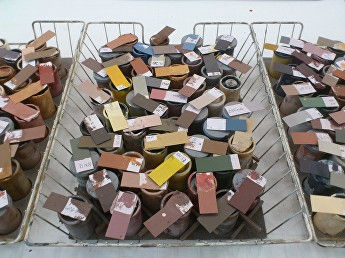Exclusive Confrontations with reality: Ben Johnson in practice
Tucked behind a discreet entrance close by a west London tube station is the studio of artist Ben Johnson. Converted by architect MJ Long from a former builder’s merchant’s premises, it forms – along with two similar spaces for other artists, all gathered around a courtyard – a quiet, creative enclave.
Inside, the space is bright, white and warm. Incomplete paintings fill two walls. One is a large, richly-coloured interior of a room from the Neues Museum, Berlin, which Johnson visited in spring 2011 (I was there at the same time and we met), its deep reds and earthy tones a trompe l’oeil against the wall. Contrasting, three panels in cool blues and whites representing the interior of John Pawson’s Novy Dvur Monastery in the Czech Republic run along the other wall; when complete, Johnson aims to hang them in a manner which encloses the viewer like a folded triptych, to simulate being in the space they depict. Finally, a smaller work highlights objects from the Neues Museum’s collection, their aged, textured surfaces standing out within the image against flat, neutral walls.
Tables carry paint pots and tools hang on the wall. An open hatch in the floor leads to a basement store. A long desk supports three computers. Near the entrance there is a kitchenette and tall, well-populated bookshelf. Reference material is pinned to walls or lying on tables, including precise, computer-generated drawings of tiles from the Alhambra palace, Spain. Their intricate geometry was reverse-engineered from the originals for Johnson by an international expert, to enable their eventual depiction in a painting by precisely-cut mask and spray head.
We begin our conversation examining high-resolution photographs of the inside of the Neues Museum on a computer monitor. Johnson explains that some are his own, taken during his visit, whilst others are by a German photographer and record the Museum’s fabric at the very start of David Chipperfield’s restoration nearly ten years ago. Johnson has manipulated both to create a merged image that is informing his work-in-progress, the large painting mentioned above that will ultimately show the Museum in an imagined state part way between then and now.





In terms of this particular project, what are you looking for when you’re looking at those images?
It’s something… it’s to try and get back to the feeling I had when I was in the building, which was above and beyond the admiration for the restoration work, because it is a phenomenal piece of craft, and I think the humility and the modesty of the architects and their intervention, to actually re-present an extraordinary building... But that building for me, it just seemed to be full of hidden voices, messages from the past, a past that was violent, very strong, painful, and maybe I’m just being over-romantic, but I don’t think I am, there is something very… the whole of Berlin makes you start questioning your knowledge, however limited it is, of the past.
That’s very interesting because I think we both found that, independently, there, and I tried to reflect that in my piece.
Do you think then in that case, that love of craft is partly the fact that it gives you control?
Which I guess again is an appreciation of craft.
So I spend a lot of time going round in a big circle[!].